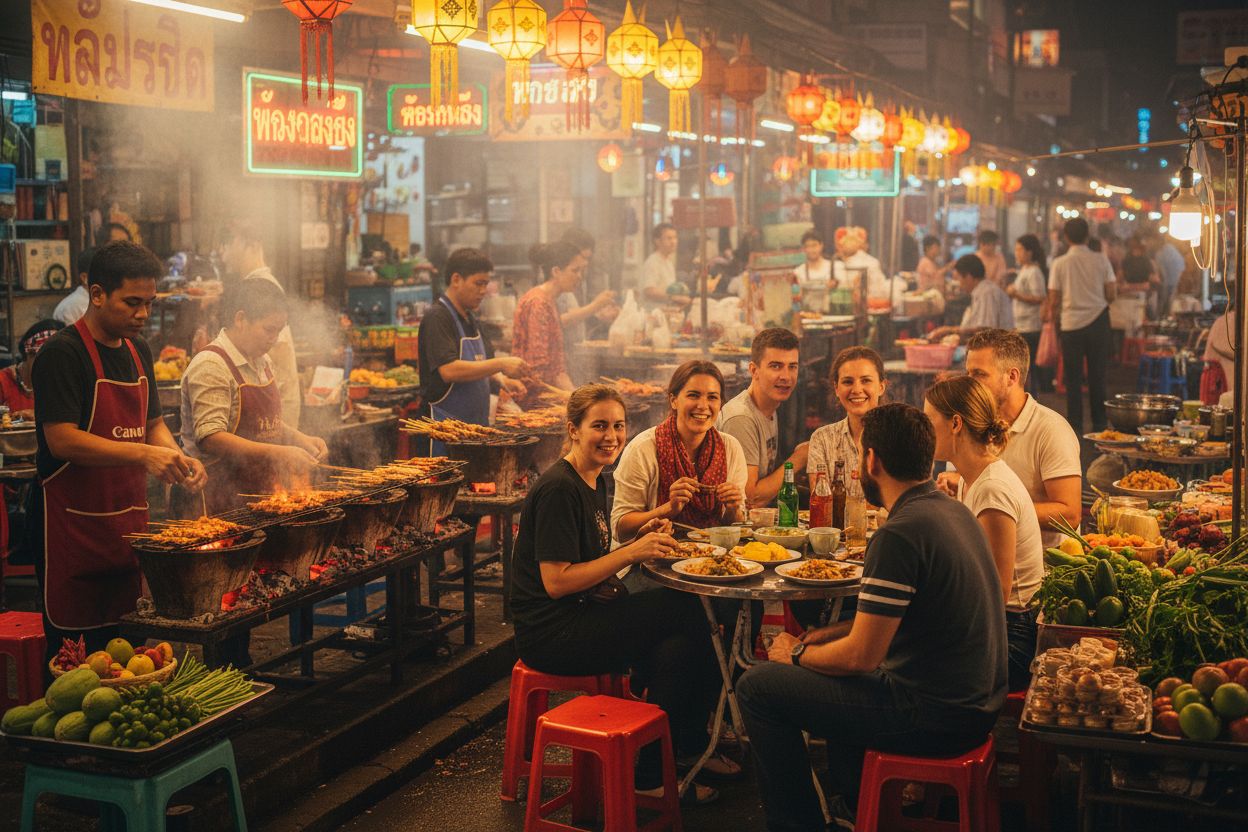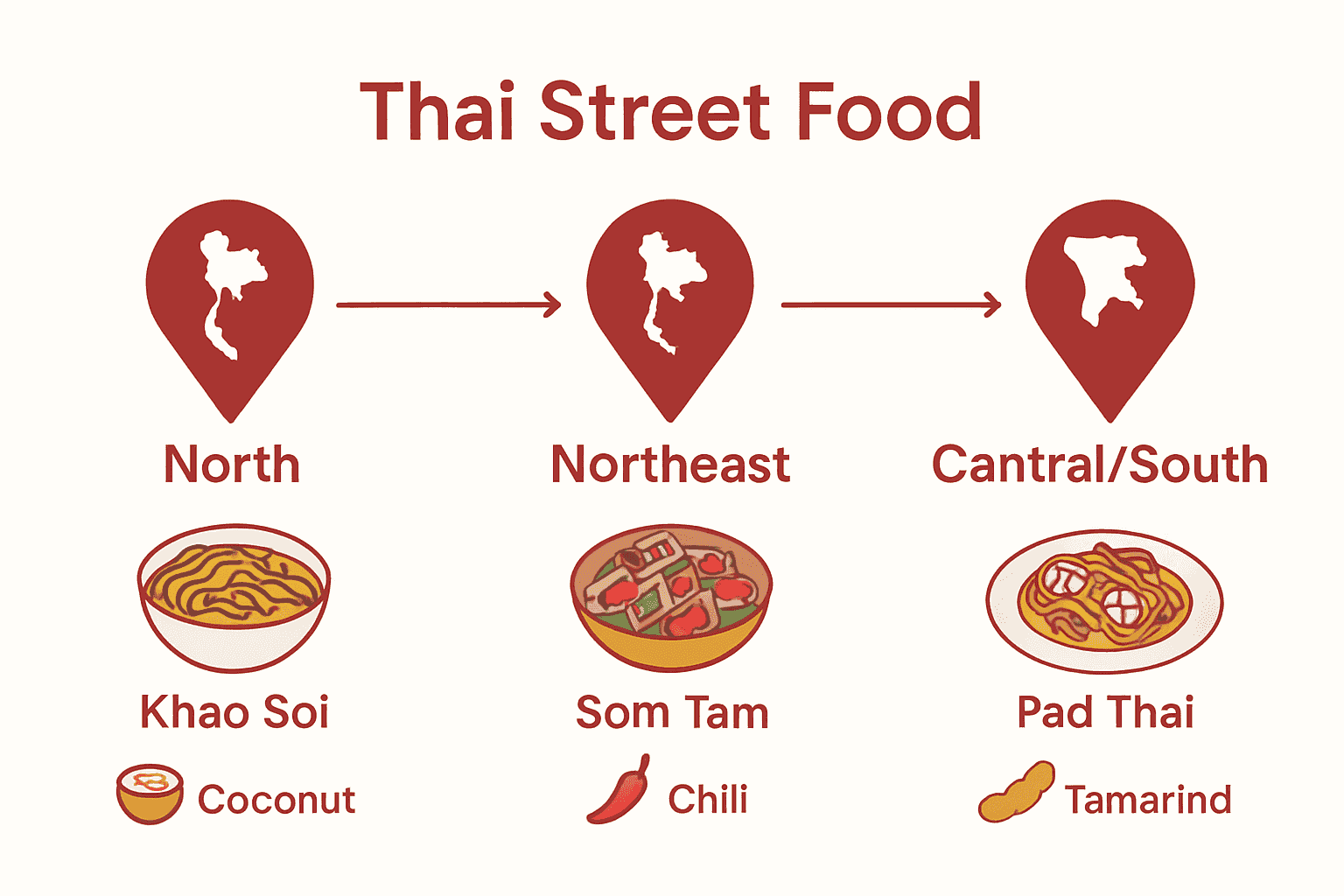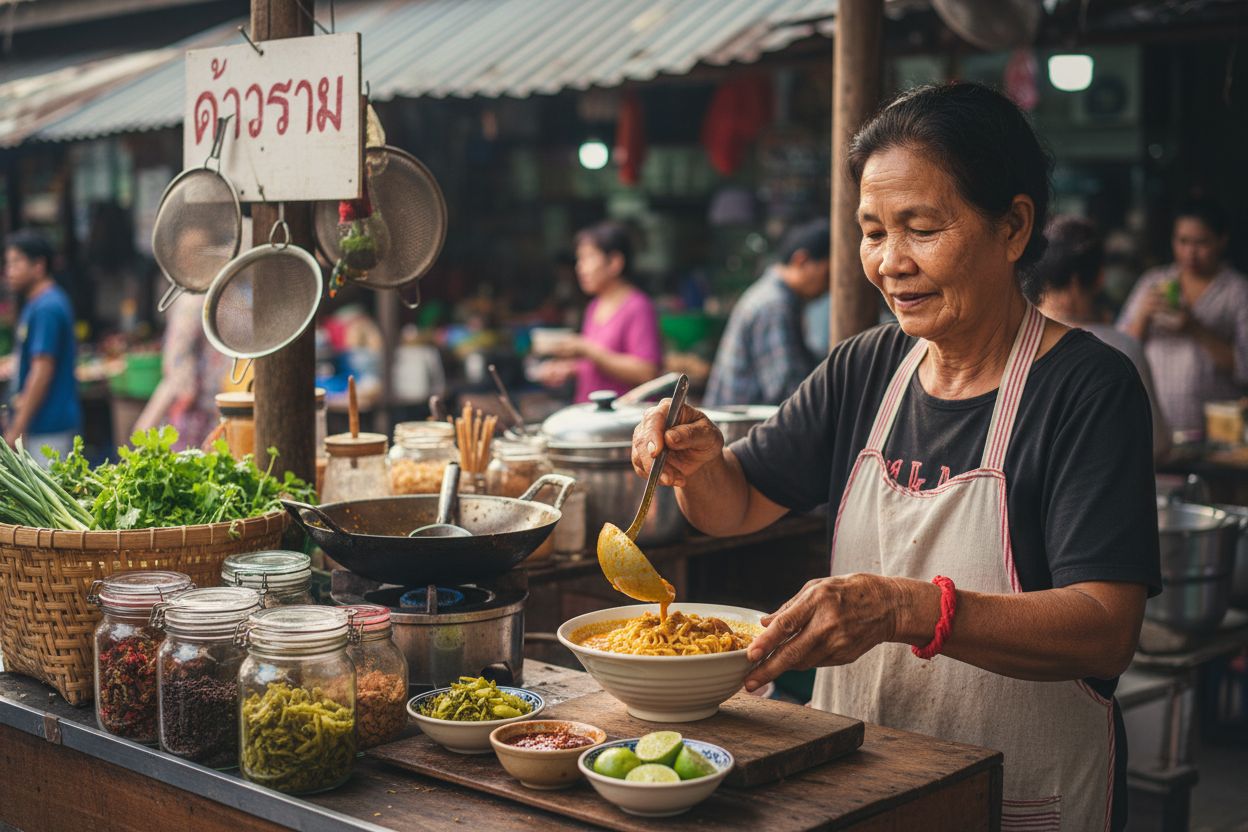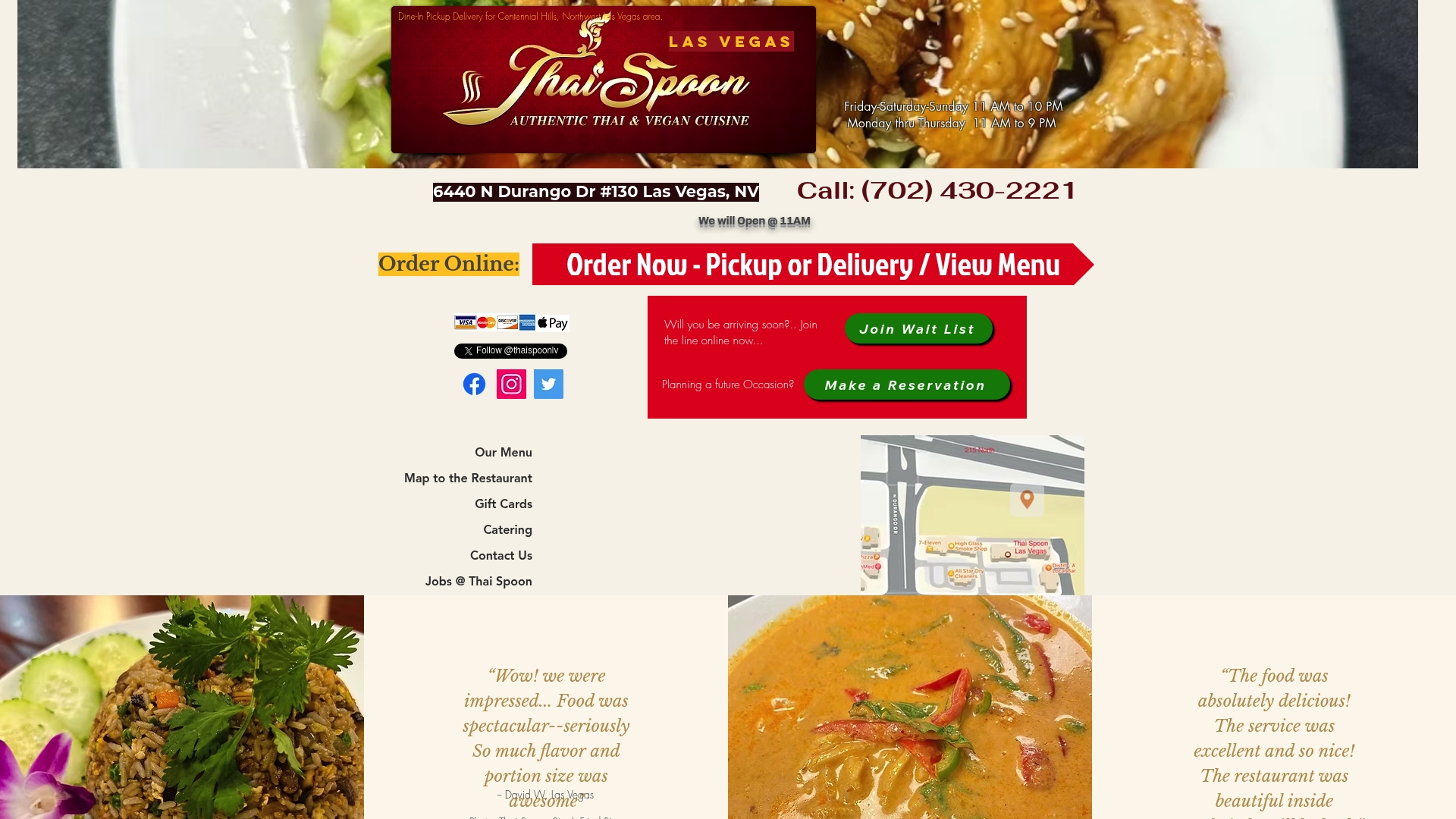What Is Thai Street Food? Complete Guide
- mail469793
- Oct 20
- 7 min read

Did you know that street vendors in Bangkok serve more than 30 percent of the city’s daily meals? Thai street food is not just a way to eat on the go. It weaves together history, community, and culinary adventure in every dish. From the busy city corners to the heart of small villages, these flavorful stalls offer a genuine slice of tradition and taste, promising experiences far beyond the ordinary restaurant meal.
Key Takeaways
Point | Details |
Culinary Origin | Thai street food emerged from Chinese enclaves in Bangkok during the early 20th century and evolved significantly due to urbanization in the 1970s. |
Cultural Significance | Beyond sustenance, street food fosters community connections, preserves culinary traditions, and serves as a vital economic contributor in urban areas. |
Diverse Offerings | Thai street food presents a wide range of dishes that vary by region, showcasing unique ingredients and flavors representative of local culinary heritage. |
Safety Considerations | Choosing high-traffic stalls, observing food preparation, and ensuring cleanliness are key to enjoying Thai street food safely and healthily. |
Table of Contents
Defining Thai Street Food and Its Roots
Thai street food represents a vibrant culinary tradition that emerged from a fascinating cultural intersection of urban life, migration, and economic transformation. According to historical research, this dynamic food culture originated in the ethnic Chinese enclaves of Bangkok during the early 20th century, with significant expansion happening in the 1970s as rapid urbanization reshaped social structures and eating habits.
During the Ayutthaya period (1350–1767), food commerce was dramatically different - with floating markets selling meals from boats being the primary method of food distribution. The transition to land-based street stalls occurred under King Rama V’s modernization efforts, marking a pivotal shift in Thailand’s culinary landscape. Street vendors began preparing ready-to-eat meals from portable carts and small stalls, gradually replacing traditional home cooking practices.
Key characteristics that define Thai street food include:
Quick preparation methods
Affordable pricing
Intense, complex flavor profiles
Highly portable meals
Reflects regional culinary diversity
Today, street food represents more than just a meal - it’s a living cultural narrative that connects generations, preserves culinary traditions, and offers an authentic glimpse into Thailand’s rich gastronomic heritage. For those seeking to understand the essence of Thai cuisine, street food provides an unfiltered, delicious gateway into the country’s culinary soul.
Popular Dishes and Regional Specialties
Thai street food offers an incredible diversity of flavors and regional specialties that reflect the country’s rich culinary heritage. According to street food experts, certain dishes have become iconic representations of Thailand’s vibrant food culture, with each region boasting its unique gastronomic signature. Regional Thai cuisine is a testament to the country’s complex culinary landscape.
In the bustling streets of Thailand, popular street dishes range from savory to sweet, offering something for every palate. Travelers and food enthusiasts can expect to encounter favorites like Moo Ping (grilled pork skewers), Khao Man Gai (Thai chicken rice), and the ubiquitous Pad Thai. Northern regions are particularly known for specialties such as Khao Soi, a rich coconut curry noodle soup, and Sai Oua, a flavorful northern Thai sausage that showcases the region’s unique spice profiles.
Street food favorites typically include:
Here’s a summary of popular Thai street food dishes by region and their key characteristics:

Dish Name | Region | Main Ingredients |
Moo Ping | Nationwide | Pork, garlic, coriander, black pepper |
Khao Soi | Northern Thailand | Egg noodles, coconut curry, chicken |
Pad Thai | Nationwide | Rice noodles, tamarind, shrimp, peanuts |
Som Tam | Northeastern (Isaan) | Green papaya, chili, lime, fish sauce |
Sai Oua | Northern Thailand | Pork, herbs, chili, spices |
Khanom Krok | Nationwide | Rice flour, coconut milk, sugar |
Grilled Moo Ping (pork skewers)
Som Tam (spicy papaya salad)
Pad Thai (stir-fried rice noodles)
Khanom Krok (coconut pancakes)
Tod Mun Pla (fish cakes)
Kai Jeow (Thai-style omelette)
Beyond just sustenance, these dishes represent a living culinary tradition that connects generations and tells the story of Thailand’s diverse cultural influences. From the sweet and tangy flavors of southern street stalls to the hearty, spice-laden dishes of the north, Thai street food offers an authentic journey through the country’s gastronomic landscape.

Flavors, Ingredients, and Cooking Methods
Thai street food is a masterful symphony of flavors, characterized by an intricate balance of sweet, sour, salty, and spicy elements that dance across the palate. Understanding authentic Thai flavors reveals a culinary philosophy that transforms simple ingredients into extraordinary dishes through careful seasoning and technique.
The ingredients used in Thai street food are a testament to the country’s rich agricultural heritage. Marinades play a crucial role, with grilled meats like Moo Ping typically featuring a complex blend of garlic, coriander roots, and black pepper. Coconut milk, fresh herbs, and local produce form the backbone of many dishes, creating layers of flavor that are both vibrant and nuanced. A classic example is Pad Thai, which brilliantly combines tamarind, palm sugar, fish sauce, lime juice, and chili to create a perfect flavor harmony.
Key cooking methods in Thai street food include:
Rapid stir-frying in high-heat woks
Grilling over charcoal
Deep-frying
Steaming
Quick-sautéing
The magic of Thai street food lies not just in its ingredients, but in the lightning-fast cooking techniques that preserve flavor and texture. Street vendors transform raw ingredients into mouthwatering meals in minutes, using portable stoves and minimal equipment.
From the sizzling sound of Kai Jeow (Thai omelette) hitting a hot pan to the precise movements of a satay grill master, these cooking methods are a performance as much as a culinary art.
Street Food Culture and Social Importance
Street food in Thailand represents far more than just a culinary tradition—it’s a vibrant social ecosystem that connects communities, preserves cultural heritage, and provides critical economic opportunities. According to research, street food culture emerged as a fundamental aspect of urban life, with street vendors becoming essential contributors to the informal economy and daily social interactions.
The urban landscape of Thailand has been dramatically shaped by street food vendors, who transformed city spaces into dynamic culinary environments. As urban populations grew, these mobile kitchens became more than just food sources—they became social hubs where people from different backgrounds converge, share meals, and exchange stories. Thai-American food writer Chawadee Nualkhair has passionately argued for preserving this crucial cultural institution, highlighting how street vendors represent not just economic actors, but creative culinary innovators.
Key social aspects of Thai street food culture include:
Providing affordable meals for working-class populations
Creating entrepreneurial opportunities for small-scale vendors
Serving as community gathering spaces
Preserving traditional cooking techniques
Offering economic mobility for families
Beyond economics, street food embodies Thailand’s spirit of community and creativity. Each cart, each recipe tells a story of family traditions, regional influences, and individual innovation. From bustling Bangkok alleys to small provincial towns, street food vendors are the unsung cultural ambassadors, keeping alive a culinary tradition that is as much about human connection as it is about delicious food.
Tips for Enjoying Thai Street Food Safely
Navigating the vibrant world of Thai street food requires a balance of adventurous spirit and smart precautions. Tips for Thai food beginners can help travelers and food enthusiasts enjoy these culinary delights without compromising their health. The key is to approach street food with informed confidence and keen observation.
When exploring street food stalls, food safety becomes paramount. Research suggests choosing busy stalls with high customer turnover, which typically indicates fresh, frequently prepared dishes. Watch how food is prepared—ideally, dishes should be cooked fresh right in front of you, ensuring maximum heat treatment and minimizing potential bacterial risks. Pay close attention to the cleanliness of the cooking area, utensils, and the vendor’s personal hygiene.
Essential safety tips for enjoying Thai street food:
Choose stalls with high customer traffic
Observe food preparation techniques
Ensure dishes are cooked thoroughly and served hot
Check utensils and cooking surfaces for cleanliness
Avoid raw or uncooked salads in uncertain environments
Drink bottled or boiled water
Trust your instincts about a stall’s overall hygiene
Beyond safety, street food is about experiencing authentic culinary traditions. By being observant and selective, you can savor incredible flavors while minimizing health risks. The street food scene is a delicious adventure—just approach it with wisdom, curiosity, and a spirit of respectful exploration.
Experience Real Thai Street Food Flavors in Las Vegas
If the article sparked your curiosity for authentic Thai street food, but you struggle to find true flavors outside of Thailand, you are not alone. Many readers crave the vibrant tastes and quick-cooked meals described here, yet feel let down by generic or overly Westernized options. Imagine enjoying expertly grilled skewers, intense spice blends, and classic dishes like Pad Thai or Som Tam, all crafted with the same deep tradition and passion found on Thailand’s bustling streets. That culinary journey does not have to remain a dream.

You can now enjoy the unmistakable taste of Thai street food closer to home at Thai Spoon Las Vegas. Explore a menu built around authentic recipes and fresh ingredients, including vegan and gluten-free options to suit your needs. Whether you crave a quick lunch, a flavorful dinner, or want to place an order online for pickup or delivery, your street food adventure begins here. Don’t wait to try Thailand’s iconic street flavors today. Visit Thai Spoon Las Vegas and let your taste buds discover what authentic is supposed to be.
Frequently Asked Questions
What is Thai street food?
Thai street food refers to the vibrant culinary tradition that includes ready-to-eat meals prepared and sold by street vendors. It showcases a blend of flavor, quick preparation, and affordability, reflecting the country’s rich cultural heritage.
What are some popular dishes in Thai street food?
Popular Thai street food dishes include Moo Ping (grilled pork skewers), Khao Man Gai (Thai chicken rice), Pad Thai (stir-fried rice noodles), Som Tam (spicy papaya salad), and Khanom Krok (coconut pancakes).
How is Thai street food prepared?
Thai street food is typically prepared using rapid cooking methods such as stir-frying, grilling, deep-frying, and steaming. Vendors often cook meals fresh in front of customers, ensuring lively flavors and quick service.
What should I consider for food safety when eating Thai street food?
To ensure food safety when enjoying Thai street food, choose stalls with high customer traffic, observe how food is prepared, ensure dishes are cooked thoroughly, check for cleanliness of utensils and surfaces, and avoid raw or uncooked salads in uncertain environments.
Recommended











Comments